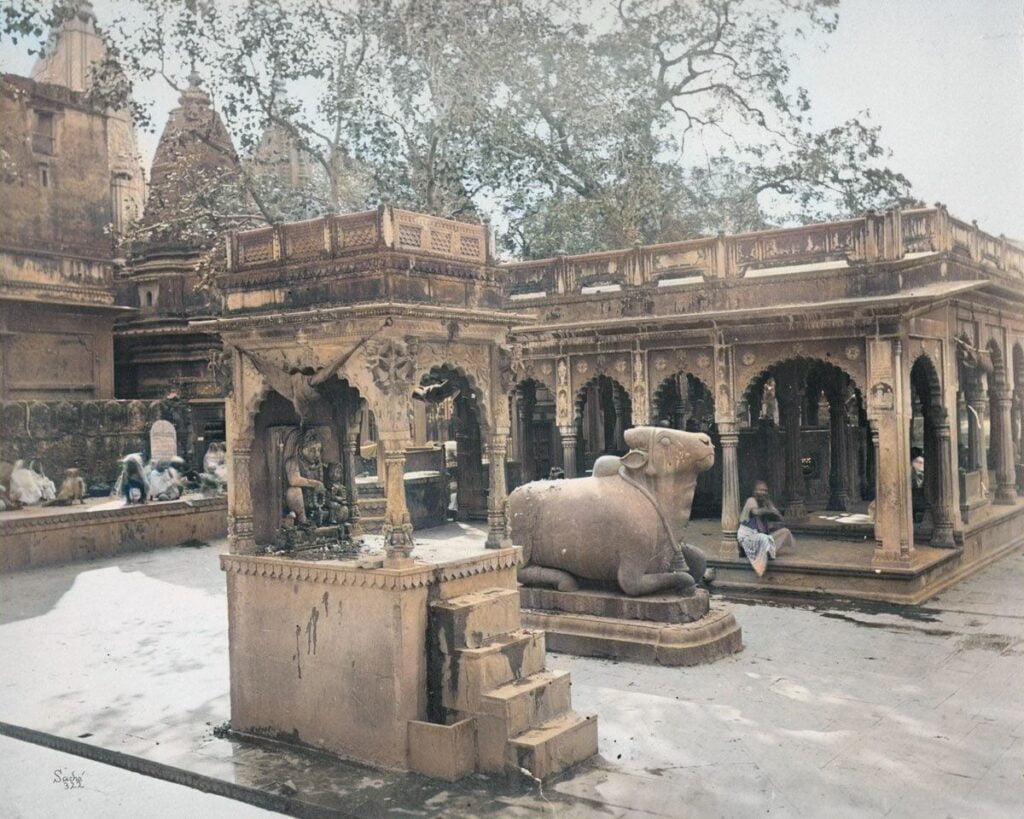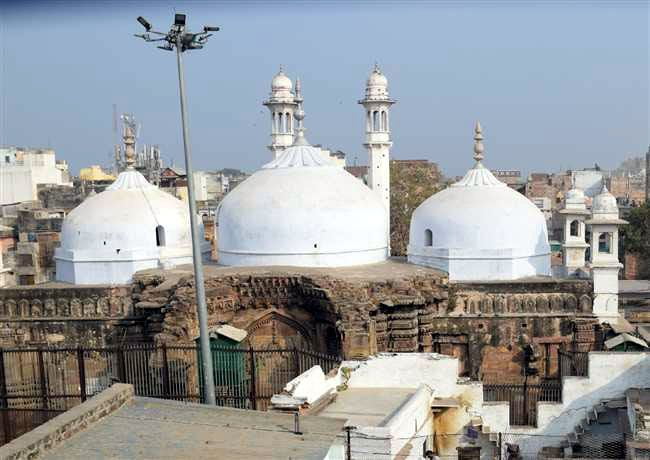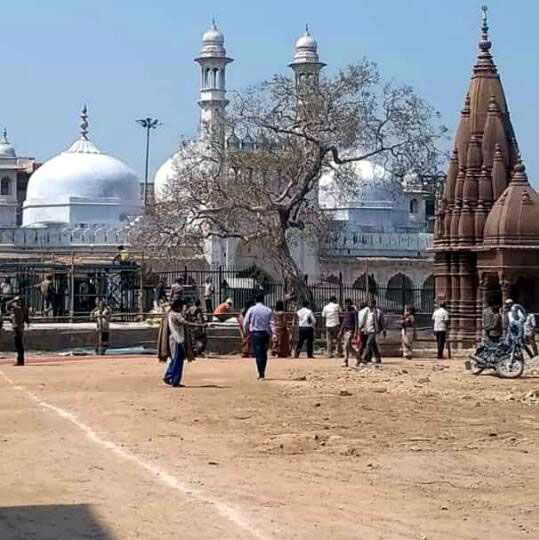Gyanvapi Temple: Unveiling the Sacred Legacy
Gyanvapi Temple or Gyanvapi Mosque is located in Varanasi, India. The Gyanvapi Mosque was built by one of the Mughal emperors Aurangzeb in the 17th century, and it is situated near the Kashi Vishwanath Temple.

Contents
- 1 Gyanvapi Temple History:
- 2 Legend of Gyanvapi Temple:
- 3 Legend of Gyanvapi Temple:
- 4 Myths and Beliefs of Gyanvapi Temple:
- 5 The Archaeological Survey of India (ASI) findings of Gyanvapi Temple:
- 6 Places to visit near Gyanvapi Temple:
- 7 FAQ:
- 7.0.1 What is the Gyanvapi Mosque?
- 7.0.2 What is the history of the Gyanvapi Mosque?
- 7.0.3 What is the current status of the Gyanvapi Mosque?
- 7.0.4 What are the arguments of the Hindus?
- 7.0.5 What are the arguments of the Muslims?
- 7.0.6 What is the likely outcome of the legal dispute?
- 7.0.7 What is the significance of the Gyanvapi Mosque?
- 7.0.8 What are some other examples of disputed religious sites in India?
- 7.0.9 What are the implications of the Gyanvapi Mosque dispute for India?
- 7.0.10 Is worship allowed in Gyanvapi mosque?
- 8 How to reach Gyanvapi Temple:
- 9 Google Maps:
Gyanvapi Temple History:
The history of the Gyanvapi Mosque is disputed. Hindus claim that the mosque was built on the site of a Hindu temple, the Kashi Vishwanath Temple. They claim that Aurangzeb demolished the temple and built the mosque in its place. Muslims, on the other hand, claim that the mosque was built on a vacant lot. They deny that Aurangzeb demolished any Hindu temples.
The dispute over the Gyanvapi Mosque has been going on for centuries. In 1991, a group of Hindu priests filed a lawsuit in court, claiming that the mosque was built on the site of a Hindu temple. The case is still pending in court.
In 2022, a court-ordered survey of the Gyanvapi Mosque was conducted. The survey team found several Hindu symbols and structures inside the mosque. These findings have further fueled the controversy over the mosque.
The Gyanvapi Mosque is a sensitive issue in India. It is a symbol of the long-standing conflict between Hindus and Muslims in the country. The dispute over the mosque is likely to continue for many years to come.
Here are some of the key events in the history of the Gyanvapi Mosque:
- 1669: Aurangzeb orders the construction of the Gyanvapi Mosque.
- 1991: Hindu priests file a lawsuit in court, claiming that the mosque was built on the site of a Hindu temple.
- 2022: A court-ordered survey of the Gyanvapi Mosque is conducted. The survey team finds several Hindu symbols and structures inside the mosque.

Legend of Gyanvapi Temple:
The legend of the Gyanvapi Temple dates back to the 11th century. According to legend, a Hindu king named Jaichand was ruling over the kingdom of Kannauj. He was a devout Shaivite, and he had a dream in which Lord Shiva appeared to him and told him to build a temple in his honor.
Jaichand built the temple on the banks of the Ganges River, and he named it the Gyanvapi Temple. The temple was said to be so beautiful that it was even more radiant than the sun.
The Gyanvapi Temple was destroyed by the Ghurids in 1194. The Ghurids were a Muslim dynasty that ruled over much of North India at the time. They destroyed many Hindu temples, including the Gyanvapi Temple.
The Gyanvapi Temple was rebuilt in the 13th century. It was again destroyed by the Mughals in the 17th century. The Mughals were a Muslim dynasty that ruled over much of India at the time. They destroyed many Hindu temples, including the Gyanvapi Temple.
The Gyanvapi Temple was again rebuilt in the 18th century. It has stood since then, and it is one of the most important Hindu temples in India.
The Gyanvapi Temple is a symbol of the resilience of Hindu culture. It has been destroyed and rebuilt many times, but it has always stood tall. The temple is a reminder of the strength of Hindu faith, and it is a source of inspiration for Hindus all over the world.

Legend of Gyanvapi Temple:
Religious Significance:
- Devotion to Lord Shiva: Hindus believe the complex houses the Kashi Vishwanath Temple, dedicated to Lord Shiva, one of the most revered deities in Hinduism. The site is considered one of the holiest in India, with millions of Hindus visiting annually for darshan (seeking blessings).
- Mythological Connections: The well within the complex, known as Gyanvapi, holds mythological significance as the location where Adi Shankaracharya, a revered Hindu philosopher, received divine knowledge.
- Ritualistic Practices: Many specific rituals are associated with the temple, including offering prayers, bathing in the Ganga River, and participating in special festivals.
Historical Significance:
- Ancient Origins: The temple’s origins are unclear, but some believe it existed millennia ago. Hindu narratives and traditions claim the mosque was built atop the temple’s ruins.
- Architectural Evidence: Some Hindu groups point to architectural features within the mosque as evidence of a pre-existing temple, though interpretations are contested.
- Symbol of Resilience: For many Hindus, the claimed destruction of the temple signifies past injustices and reclaiming the site represents historical truth and cultural revival.
Cultural Significance:
- Center of Varanasi: The city of Varanasi, where the complex is located, is considered a holy city for Hindus. The temple/mosque complex plays a central role in Varanasi’s cultural identity and attracts both locals and tourists.
- Symbol of Religious Tolerance: Historically, Varanasi has seen coexistence of different religions. While the current dispute presents a complex situation, the Gyanvapi complex exemplifies the long-standing interaction and exchange between Hinduism and Islam in India.

Myths and Beliefs of Gyanvapi Temple:
Hindu Myths and Beliefs:
- Pre-existing Temple: Hindus believe that a grand temple dedicated to Adi Vishweshwar (Lord Shiva) existed on the site for millennia. This temple is said to be one of the twelve Jyotirlingas, sacred representations of Shiva’s light. Legends claim that the temple was built by different deities and figures throughout history, including Brahma, Vishnu, and King Harishchandra.
- Destruction and Reconstruction: Hindus believe that the Mughal emperor Aurangzeb demolished the temple in the 17th century and built the Gyanvapi Mosque on its ruins. They often cite the presence of Hindu architectural elements within the mosque complex as evidence of this destruction.
- Continuing Presence of Shiva: Despite the destruction, Hindus believe that the Jyotirlinga remains present beneath the mosque, its sanctity undiminished. Devotees consider the well within the mosque complex to be sacred, believing it leads to the Jyotirlinga.
- Significance of Kashi: The city of Kashi (Varanasi), where the Gyanvapi complex is located, holds immense importance in Hinduism. It is considered the holiest city in India, and many Hindus believe that dying in Kashi grants liberation from the cycle of rebirth. The presence of the Jyotirlinga in Kashi further elevates its significance.
The Archaeological Survey of India (ASI) findings of Gyanvapi Temple:
The Archaeological Survey of India (ASI) submitted its report on the Gyanvapi mosque complex in Varanasi, India, on January 25, 2024, to both Hindu and Muslim parties involved in the ongoing legal dispute. While the full report is not publicly available, some key findings have been revealed:
Evidence of a pre-existing Hindu temple:
- The ASI report concluded that structural remains of an older building, likely a temple, were found beneath the Gyanvapi mosque. This included pillars, slabs, and other architectural elements with Hindu motifs such as lotus designs, amalakas (decorative elements), and inscriptions in Devanagari script.
- The report also mentioned inscriptions containing names of Hindu deities like Vishnu, Ganesha, and Nandi.
Reusing elements from the temple:
- The ASI report noted that some of the architectural elements from the pre-existing temple were reused in the construction of the Gyanvapi mosque. This suggests that the mosque was built partially on top of the demolished temple structure.
Nature of the pre-existing structure:
- The exact nature and size of the pre-existing structure remain unclear. The ASI report describes it as a “structure of significant size”, but its specific type (temple, palace, etc.) and age are not definitively determined.
Reactions to the findings:
- The Hindu petitioners in the legal case welcomed the report, claiming it vindicates their belief that a temple existed before the mosque.
- Muslim groups have expressed concerns about the report’s interpretation and the potential implications for the mosque’s status.
Places to visit near Gyanvapi Temple:
- Kashi Vishwanath Temple: While the Gyanvapi Temple is associated with controversy, the Kashi Vishwanath Temple is one of the most sacred and important temples dedicated to Lord Shiva. It attracts a large number of pilgrims and tourists.
- Dashashwamedh Ghat: This is one of the oldest and most famous ghats in Varanasi, located on the banks of the Ganges River. It is known for its evening Ganga Aarti, a mesmerizing ritual performed by priests.
- Assi Ghat: Another prominent ghat on the Ganges, Assi Ghat is known for its peaceful surroundings and is a popular place for meditation and yoga.
- Sarnath: Located just a few kilometers from Varanasi, Sarnath is an important Buddhist pilgrimage site. It is where Gautama Buddha is said to have given his first sermon after attaining enlightenment.
- Bharat Kala Bhavan Museum: Situated within the Banaras Hindu University (BHU) campus, this museum houses a vast collection of artifacts, paintings, and sculptures, providing insights into the cultural history of Varanasi.
- Tulsi Manas Mandir: This temple is dedicated to Lord Rama and is believed to be located at the spot where Tulsidas composed the Ramcharitmanas, an epic poem on the life of Lord Rama.
- Ramnagar Fort: Situated on the eastern bank of the Ganges River, this fort is known for its impressive architecture and houses a museum displaying vintage cars, royal costumes, and weaponry.
- Durga Temple (Durga Kund Mandir): This temple is dedicated to Goddess Durga and is known for its vibrant colors and architectural beauty.
FAQ:
What is the Gyanvapi Mosque?
The Gyanvapi Mosque is a mosque located in Varanasi, Uttar Pradesh, India. It is located next to the Kashi Vishwanath Temple, one of the holiest Hindu temples in the world.
What is the history of the Gyanvapi Mosque?
The Gyanvapi Mosque was built in the 17th century by Aurangzeb, the Mughal emperor. It is believed that the mosque was built on the site of a Hindu temple that was destroyed by Aurangzeb.
What is the current status of the Gyanvapi Mosque?
The Gyanvapi Mosque is currently a place of worship for Muslims. However, there is a legal dispute over the ownership of the mosque. Hindus have filed a petition in court claiming that the mosque was built on the site of a Hindu temple and that it should be returned to them.
What are the arguments of the Hindus?
Hindus argue that the Gyanvapi Mosque was built on the site of a Hindu temple that was destroyed by Aurangzeb. They cite historical evidence and architectural features of the mosque to support their claim.
What are the arguments of the Muslims?
Muslims argue that the Gyanvapi Mosque has been a place of worship for Muslims for centuries. They deny that the mosque was built on the site of a Hindu temple and that there is no evidence to support this claim.
What is the likely outcome of the legal dispute?
The legal dispute over the ownership of the Gyanvapi Mosque is likely to be a long and protracted one. It is unclear what the outcome of the dispute will be.
What is the significance of the Gyanvapi Mosque?
The Gyanvapi Mosque is a significant religious site for both Hindus and Muslims. The legal dispute over the ownership of the mosque is a sensitive issue that has the potential to inflame religious tensions in India.
What are some other examples of disputed religious sites in India?
There are a number of other disputed religious sites in India, including the Babri Masjid in Ayodhya, the Ram Janmabhoomi in Ayodhya, and the Krishna Janmabhoomi in Mathura.
What are the implications of the Gyanvapi Mosque dispute for India?
The Gyanvapi Mosque dispute is a reminder of the complex and sensitive nature of religious issues in India. The dispute has the potential to inflame religious tensions and to undermine the country’s secular fabric.
Is worship allowed in Gyanvapi mosque?
How to reach Gyanvapi Temple:
By Air: The nearest airport to Varanasi is Lal Bahadur Shastri International Airport. From the airport, you can hire a taxi or use other transportation options to reach the mandir.
By Train: Varanasi Junction is the main railway station in the city. It is well-connected to major cities across India. From the railway station, you can take a taxi, auto-rickshaw, or other local transportation to reach Gyanvapi temple.
By Road: Varanasi is well-connected by road, and you can reach the city by bus or private vehicle. Once you reach Varanasi, you can navigate through the city to reach Gyanvapi temple. You can use a map or GPS for navigation.
